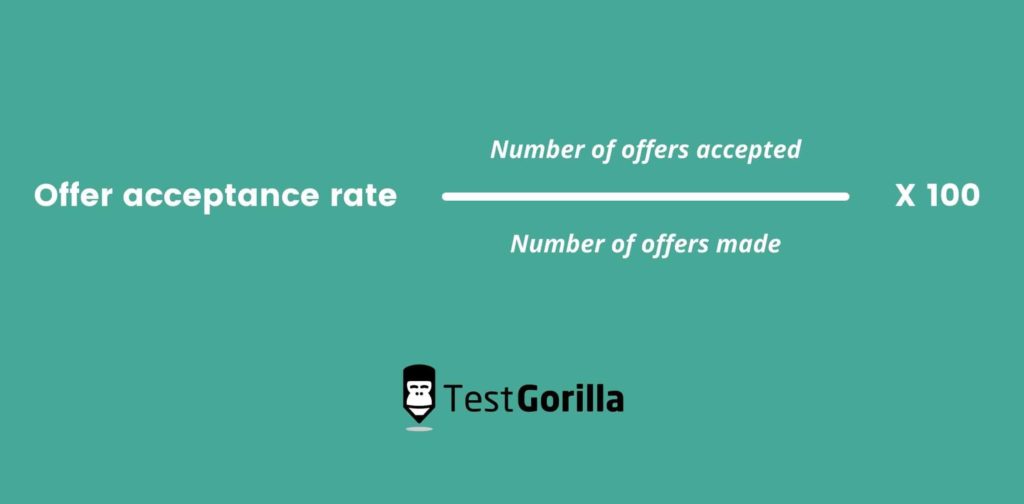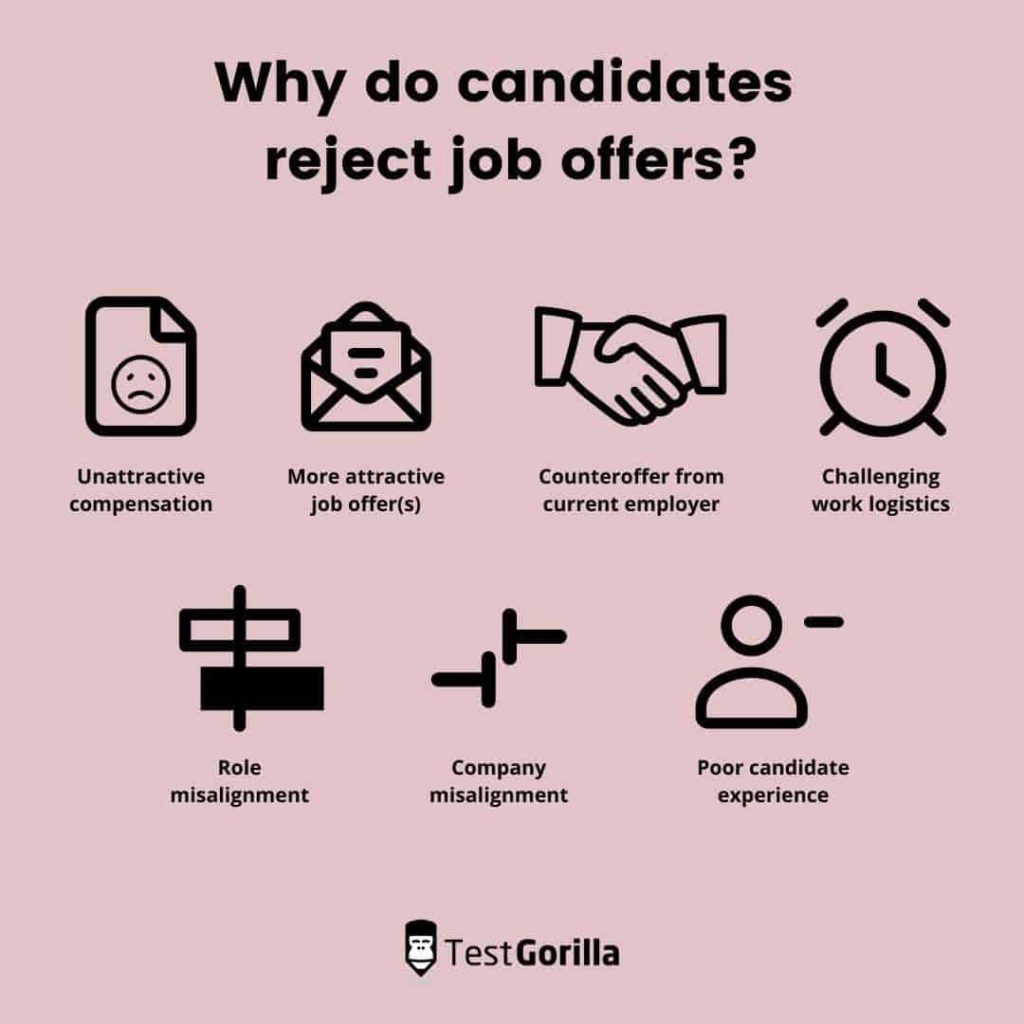It’s frustrating to extend a job offer to a candidate only to have them back out at the last minute.
Having this happen once or twice could be bad luck.
But if job candidates are repeatedly passing on your offers, you likely have bigger issues in your recruitment process.
Given that a single hire costs recruiters $4,129 on average, getting all the way to the offer stage and then needing to restart the recruitment process can carry a major price tag.
One way to identify where things may be going right or wrong is by tracking your offer acceptance rate.
In this article, we’ll review how to calculate and improve your offer acceptance rate, giving you the tools you need to land more of your top candidates.
Table of contents
- What is an offer acceptance rate (OAR)?
- What does your offer acceptance rate tell you?
- How to calculate offer acceptance rate
- What is a good offer acceptance rate for recruitment?
- Why do candidates reject job offers?
- Tips for improving your offer acceptance rate
- Improve your offer acceptance rate with TestGorilla
What is an offer acceptance rate (OAR)?
Offer acceptance rate (OAR) is the percentage of formal job offers your company extends to external candidates who get accepted.
By closely tracking your offer acceptance rate, you can uncover what factors are impacting a candidate’s decision when they are considering whether to work at your company.
It’s one of many recruitment metrics — such as application completion rate, applicant to interview rate, and interview to offer rate — that aim to diagnose what’s happening at each stage of your recruitment pipeline.
What does your offer acceptance rate tell you?
On the surface, OAR measures how effective your recruitment strategy is at closing candidates in the final stage of the recruitment process.
However, because your entire recruitment process feeds into this final stage, issues with previous recruitment steps will also impact your offer acceptance rate.
For example, if you don’t discuss compensation with candidates during your screening process, you could end up with lots of candidates dropping out once they see what the job pays.
By tracking OAR, you can learn:
How accurate your job descriptions are
How effectively you are screening candidates
How your compensation compares to the market
How attractive your employer brand is
The best insights on HR and recruitment, delivered to your inbox.
Biweekly updates. No spam. Unsubscribe any time.
How to calculate offer acceptance rate
To calculate your offer acceptance rate, simply divide the number of accepted offers by the total number of job offers that went out to candidates:
Number of accepted job offers *100%/ Number of total offers
When calculating your OAR, only include formal job offers to external candidates. You shouldn’t include offers made to internal candidates, as the factors that impact why they accept an offer will be significantly different from those that impact external candidates.
OAR is typically calculated annually, as companies try to avoid making conclusions about their recruitment process using small sample sizes. However, if you are hiring lots of candidates on a regular basis, you can also consider calculating your OAR monthly.
Offer acceptance rate is most often calculated at the company level, but you can also track it by department, hiring manager, or recruiter to see if there are any teams or individuals who are having an outsized impact on whether offers are accepted.
What is a good offer acceptance rate for recruitment?
According to the 2017 Talent Acquisition Benchmarking Report from SHRM, the average offer acceptance rate was 91%, while the median OAR was 96%. Three-quarters of companies had an OAR of at least 86%.
You should take these figures with a grain of salt, as hiring conditions have changed dramatically since 2017. Some industries are also more competitive than others, which impacts OARs.
As a general ballpark, an OAR above 90% is strong. If your OAR is 80-90%, you may have a few issues on your hands. If your OAR is below 80%, sound the alarms.
Why do candidates reject job offers?
Before we jump into solutions for improving your offer acceptance rate, let’s explore a few reasons why candidates may be rejecting your job offers.
1. Unattractive compensation
The role’s salary, benefits, and total compensation package will be a make-or-break acceptance factor for all candidates. If salary is not transparently discussed by both parties until the end of the recruitment process, this can create misalignment.
2. More attractive job offer(s)
Your favorite candidate is likely another company’s favorite candidate too. If a candidate rejects your offer, it’s possible they have a better offer on the table from one or more other companies.
3. Counteroffer from current employer
Some candidates — especially passive candidates — may be quite content in their current role. They may have interviewed at your company as a way to test their value on the open market or to push their current employer to give them a promotion or a raise. Even in cases where candidates were initially eager to leave their current roles, their current employer may have offered up a counteroffer they couldn’t refuse.
4. Challenging work logistics
Your company’s location and working hours may not align with a candidate’s personal situation or responsibilities. For example, if your job requires strict working hours, it may not be a fit for a candidate who requires more work-life flexibility.
5. Role misalignment
It’s possible for a candidate to lose interest after learning more about the role during the interview. This can happen because the role was misrepresented in the job description or during screening calls.
6. Company misalignment
Even if the role seems like a fit, a candidate may reject an offer if your company doesn’t seem like a fit. The candidate may have a negative perception of your company culture, leadership philosophy, or business outlook.
7. Poor candidate experience
Every touchpoint with your candidates during your recruitment funnel — including the application process, screening calls, interviews, and offer process — adds up to an overall candidate experience. If a candidate has a rocky candidate experience, they can develop a negative impression of your company.
Tips for improving your offer acceptance rate
So, what can you do to avoid these issues?
1. Write better job descriptions
The more accurate your job descriptions, the more candidates can self-screen. The key word here is accurate. Don’t fluff up a job description to make it seem more enticing than it is.
To ensure your job descriptions are attractive yet accurate, have them double-checked by someone who’s been in the role before.
Your job descriptions should include:
A list of responsibilities and duties
The necessary skills or qualifications to perform the role
Working conditions
Salary information, if possible
The more you include in the job description, the fewer surprises there will be for the candidate down the line.
2. Revise your compensation
If candidates are routinely getting better offers from other companies, consider reviewing your compensation relative to industry or local benchmarks.
However, it may not be possible to raise compensation. If that’s the case, your goal should be to be more transparent about compensation upfront so that you can disqualify candidates with higher salary demands earlier on in the process.
Also, keep in mind that you can often overcome compensation issues if candidates perceive working at your company as a great personal opportunity that goes above and beyond the financial opportunity. So even if candidates cite compensation as the reason for rejecting an offer, consider that it may be for other unspoken reasons.
3. Ask the tough screening questions upfront
Whether it’s to discover salary demands or other deal breaker requirements, you have to ask the tough questions upfront to avoid spending time on candidates who are never going to be a fit.
You should ask about:
Their salary or wage requirements
Additional benefit requirements
Working condition requirements (e.g., can they work during your company’s business hours?)
Whether they need to relocate for the role
Whether they’re interviewing elsewhere and how far along they are in the process
The candidate isn’t required to answer all of these questions; however, you’ll be more likely to get honest responses if you explain that it will help ensure alignment throughout the recruitment process.
4. Speed up your recruitment process
If candidates are accepting offers from other companies, your recruitment process or time to offer may be too slow.
The SHRM benchmark report we mentioned above found that the average offer to acceptance time is four days, while the median is two days.
Therefore, if you have delayed extending an offer to a candidate for two days, they could have already received and accepted an offer from another company during that period.
Other than employing a greater sense of urgency, here are some other tools and tactics you can use to reduce your time to offer or time to hire:
Use an applicant tracking system (ATS) to improve efficiency
Use recruiting automation approaches, such as chatbots
Use pre-employment assessments to identify better candidates
Shortlist fewer candidates to hold fewer interviews
Better prepare for interviews to speed up the offer stage
5. Use pre-employment assessments
TestGorilla’s pre-employment assessments are collections of screening tests you can give to candidates when they apply for a role.
Before you even review a candidate’s CV, you can test them on:
Personality and culture add
Cognitive ability
Language skills
Situational judgment
Software skills
Role-specific skills
Using pre-employment assessments has tons of trickle-down benefits that will improve your entire recruitment process:
Save time by reviewing fewer CVs and interviewing fewer unqualified candidates
Avoid hiring bias by using a standardized qualification process
Hire better employees by identifying qualified candidates
Provide a top-tier candidate experience by showing your dedication to using the right tools and building a great team.
6. Provide a premium candidate experience
Every touchpoint your candidate has with you during the hiring process paints a picture of what it would be like to work with you. Don’t wait until the offer stage to start impressing the candidate.
To provide a first-rate candidate experience:
Make it easy to apply
Follow up regularly
Tell them what to expect throughout the process
Be transparent and authentic
Introduce them to several team members
7. Invest in employer branding
Finally, it pays to be perceived as an employer of choice. If candidates research your company and all they can find about what it’s like to work for you are negative reviews on Glassdoor, it doesn’t matter how attractive the role is.
To improve your employer brand:
In collaboration with your team, document your company culture and values
Analyze current employees’ and previous candidates’ feedback about your company
Perform a brand audit of your online profiles
Create your employee value proposition (i.e., the benefits of working for your organization)
Reinforce your value proposition through content on your website, social media profiles, and job boards
Improve your offer acceptance rate with TestGorilla
To recap, you need to closely track your offer acceptance rate to discover how well you’re doing in terms of screening candidates, compensation package, and employer branding.
If you want to boost your offer acceptance rate, take the following steps:
Write accurate job descriptions.
Review your compensation relative to industry standards.
Ask the tough questions upfront.
Reduce your time to hire and speed up the hiring process.
Use pre-employment tests.
Improve candidate experience.
Elevate your employer brand.
With TestGorilla, you can screen more candidates, identify better candidates, and improve the overall candidate experience.
To improve your offer acceptance rate, try TestGorilla for free today.
You've scrolled this far
Why not try TestGorilla for free, and see what happens when you put skills first.

















